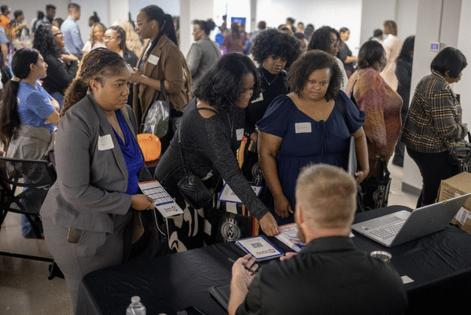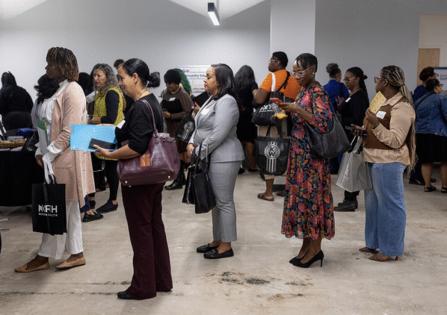Black workers bear the brunt of a stagnant US job market
Published in Business News
As the U.S. labor market falters, Black people are shouldering the burden more than any other American demographic.
The Black unemployment rate is rising nationwide, and in Minnesota it has more than doubled from last year’s low.
Hundreds of thousands of Black women have lost or left jobs, making headlines as government layoffs and a retreat from diversity, equity and inclusion efforts take a nationwide toll.
These widespread job losses, which could portend a greater downturn, are forcing Black workers into an unfriendly market where hiring has come to a near standstill and long-term unemployment is on the rise.
“There’s concern that anyone involuntarily separating (from the workforce) at this point, for whatever reason, is potentially teed up to have a longer, harder road back to employment,” said Abigail Wozniak, vice president and director of the Minneapolis Fed’s Opportunity & Inclusive Growth Institute.
While the overall U.S. unemployment rate has hovered around 4% this year, the Black unemployment rate reached 7.5% in August, the most recent month of available data.
In Minnesota, the unemployment rate for Black residents was 7.7% in August, up from 5.2% the year before. Earlier in 2024, that number fell in line with the rest of the state at 3% — the level where white Minnesotans remain.
Erica Swain, 41, lost her job in mass layoffs due to federal funding cuts at the Minnesota Department of Health in April. The Woodbury, Minnesota, resident said she and her husband, who is working two jobs, want to stay in Minnesota to continue services for their daughter, who has autism.
But it’s been hard to find any job, much less something in the public sector, where Swain has spent her career.
“I’ve been out of work maybe once or twice but never for this long,” she said Friday at a job fair for Black women in south Minneapolis. “It does feel different.”
The job fair, organized by former Star Tribune contributing columnist Sheletta Brundidge, drew more than 200 women and employers from local government, banking, health care and other industries.
An abrupt, nationwide drop this year in the number of employed Black women has set off alarms, with news coverage pointing to a decline of more than 300,000 workers between February and April.
Factoring in month-to-month ups and downs, the number of working Black women declined about 200,000 year-over-year in August. The number of workers in every other racial and gender group regularly included in federal data — including Black men — grew during that time.
The Minnesota Department of Employment and Economic Development (DEED) does not track unemployment by both race and gender, so the status of Black women in the state is unclear. Women as a whole have a higher unemployment rate and lower labor force participation rate than men because they tend to shoulder caretaking responsibilities, according to Labor Market Information Director Angelina Nguyễn.
Despite rising unemployment, Black Minnesotans have stayed in the labor market. Their labor force participation rate — the measure of people either employed or looking for work — is down from last year but still substantially higher than that of white Minnesotans and the country as a whole.
Nationally, Black women have lower labor force participation but also lower unemployment than Black men. And because Black women are more likely than white women to be the family provider, one job loss has the potential to jeopardize an entire household.
“Black women are more likely than any demographic group to be enrolled in higher education, represent the highest-growing group of entrepreneurs and disproportionately serve as breadwinners for our families,” U.S. Rep. Ayanna Pressley, D-Massachusetts, wrote in a Sept. 8 letter to Fed Chair Jerome Powell. “When coupled with the fact that job openings and hires decreased overall since July 2024, you should see the current economic outlook as a glaring red flag that forbodes danger for the entire country.”
A spokeswoman for Pressley’s office said in an Oct. 10 email that the Fed had not responded to the letter, which included requests for data on the economic impact of Black women’s job losses and a plan to address the disparity.
Angela Porter, 44, attended the Friday job fair with her mother and 16-year-old daughter. She lost her hospital security job at the end of August, she said, and is in the process of appealing an unemployment insurance claim denial.
“The economy is getting worse, and so me getting terminated at a time like this is extra hard,” said Porter, of New Hope, Minnesota. “I have to feed my kids. My rent is $1,800.”
After 17 years at Wells Fargo, Vanessa Carmichael, 70, was laid off by the bank a year and a half ago. The Maple Grove, Minnesota, resident said she’s not ready to retire — and her husband’s recent health problems mean a lot of medical bills — but she’s struggled to find work, even with several advanced degrees.
“I feel like I’ve applied to thousands of jobs,” Carmichael said. “I don’t know what to do.”
In the corner, beyond the employer tables, there was a glass door marked “Prayer Room.”
One by one, the women entered, took a seat in a folding chair and bowed their heads.
©2025 The Minnesota Star Tribune. Visit at startribune.com. Distributed by Tribune Content Agency, LLC.















Comments